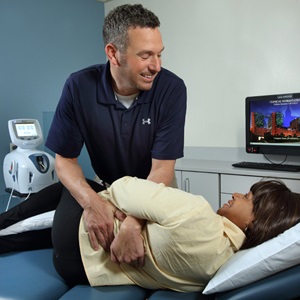Chronic Pain
What is pain?
Pain starts in receptor nerve cells found beneath the skin and in organs throughout the body. When you are sick, injured, or have other type of problem, these receptor cells send messages along nerve pathways to the spinal cord, which then carries the message to the brain. Pain medicine reduces or blocks these messages before they reach the brain.
Pain can be anything from a slightly bothersome, such as a mild headache, to something excruciating and emergent, such as the chest pain that accompanies a heart attack, or pain of kidney stones. Pain can be acute, meaning new, subacute, lasting for a few weeks or months, and chronic, when it lasts for more than 3 months.
Chronic pain is one of the most costly health problem in U.S. Increased medical expenses, lost income, lost productivity, compensation payments, and legal charges are some of the economic consequences of chronic pain. Consider the following:
-
Low back pain is one of the most significant health problems. Back pain is a common cause of activity limitation in adults.
-
Cancer pain affects most people with advanced cancer.
-
Arthritis pain affects more than 50 million Americans each year.
-
Headaches affect millions of U.S. adults. Some of the most common types of chronic headaches are migraines, cluster headaches, and tension headaches.
-
Other pain disorders such as the neuralgias and neuropathies that affect nerves throughout the body, pain due to damage to the central nervous system (the brain and spinal cord), as well as pain where no physical cause can be found--psychogenic pain--increase the total number of reported cases.
7 Ways to Treat Chronic Back Pain Without Surgery

Back pain is considered chronic if it lasts three months or longer. And in some cases, it’s difficult to pinpoint the exact cause. “If your doctor has exhausted all diagnostic options, it’s time to seek a second opinion,” recommends a back pain rehabilitation specialist.
What are the different types of pain?
Two types of pain include the following:
-
Acute pain. This pain may come from inflammation, tissue damage, injury, illness, or recent surgery. It usually lasts less than a week or two. The pain usually ends after the underlying cause is treated or has been resolved.
-
Chronic pain. Pain that persists for months or even years.
What is chronic pain?
Chronic pain is long standing pain that persists beyond the usual recovery period or occurs along with a chronic health condition, such as arthritis. Chronic pain may be "on" and "off" or continuous. It may affect people to the point that they can't work, eat properly, take part in physical activity, or enjoy life.
Chronic pain is a major medical condition that can and should be treated.
What causes chronic pain?
There are many causes of chronic pain. It may have started from an illness or injury, from which you may have long since recovered from, but pain remained. Or there may be an ongoing cause of pain, such as arthritis or cancer. Many people suffer chronic pain in the absence of any past injury or evidence of illness.
What is the "terrible triad?"
When pain becomes such a problem that it interferes with your life's work and normal activities, you may become the victim of a vicious circle. Pain may cause you to become preoccupied with the pain, depressed, and irritable. Depression and irritability often leads to insomnia and weariness, leading to more irritability, depression, and pain. This state is called the "terrible triad" of suffering, sleeplessness, and sadness. The urge to stop the pain can make some people drug-dependent, and may drive others to have repeated surgeries, or resort to questionable treatments. The situation can often be as hard on the family as it is on the one suffering with the pain.
How is chronic pain treated?
Chronic pain affects all parts of your life. The most effective treatment includes symptom relief and support. A multidisciplinary approach to pain management is often required to provide the needed interventions to help manage the pain. Pain management programs are usually done on an outpatient basis. Many skilled professionals are part of the pain management rehabilitation team, including:
-
Neurologists and neurosurgeons
-
Orthopedists and orthopedic surgeons
-
Anesthesiologists
-
Oncologists
-
Physiatrists
-
Nurses
-
Physical therapists
-
Occupational therapists
-
Psychologists/psychiatrists
-
Social workers
-
Case managers
-
Vocational counselors
Special pain programs are located in many hospitals, rehab facilities, and pain clinics.
The pain management rehab program
A pain management rehab program is designed to meet your needs. The program will depend on the specific type of pain, disease, or condition. Active involvement by you and your family is vital to the success of the program.
The goal of pain management programs is to help you return to the highest level of function and independence possible, while improving the overall quality of life--physically, emotionally and socially. Pain management techniques help reduce your suffering.
To help reach these goals, pain management programs may include:
-
Medical management of chronic pain, including medicine management:
-
Over-the-counter (OTC) medicines may include nonsteroidal anti-inflammatory drugs (NSAIDs), aspirin, or acetaminophen.
-
Prescription pain medicines, including opioids, may be needed to provide stronger pain relief than aspirin. However, these drugs are reserved for more severe types of pain, as they have some potential for abuse and may have unpleasant and potentially very dangerous side effects.
-
Prescription antidepressants can help some people. These medicines increase the supply of the naturally produced neurotransmitters, serotonin and norepinephrine. Serotonin is an important part of a pain-controlling pathway in the brain.
-
-
Heat and cold treatments to reduce the stiffness and pain, especially with joint problems such as arthritis
-
Physical and occupational therapy such as massage and whirlpool treatments
-
Exercise to reduce spasticity, joint contractures, joint inflammation, spinal alignment problems, or muscle weakening and shrinking to prevent further problems
-
Local electrical stimulation involving application(s) of brief pulses of electricity to nerve endings under the skin to provide pain relief
-
Injection therapies, such as epidural steroid injection
-
Emotional and psychological support for pain, which may include the following:
-
Psychotherapy and group therapy
-
Stress management
-
Relaxation training
-
Meditation
-
Hypnosis
-
Biofeedback
-
Behavior changes
-
The philosophy common to all of these varied psychological approaches is the belief that you can do something on your own to control pain. This includes changing your attitudes, the perception of being a victim, feelings, or behaviors associated with pain, or understanding how unconscious forces and past events have contributed to pain.
-
Patient and family education and counseling
-
Alternative medicine and therapy treatments, as appropriate
In addition, treatment may include:
-
Surgery. Surgery may be considered for chronic pain. Surgery can bring release from pain, but may also destroy other sensations as well, or become the source of new pain. Relief is not necessarily permanent, and pain may return. There is a variety of operations to relieve pain. Consult your doctor or more information.
-
Acupuncture. Acupuncture is a 2000-year-old Chinese technique of inserting fine needles under the skin at selected points in the body, and has shown some promise in the treatment of chronic pain. Needles are manipulated by the practitioner to produce pain relief.





